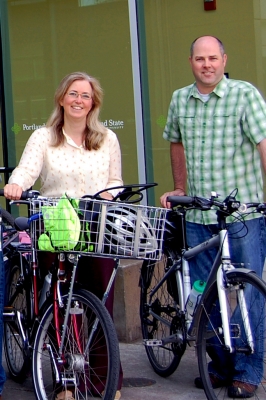OTREC researchers make AASHTO's top 16 high value research projects
Posted on July 19, 2013

Jennifer Dill and Chris Monsere with bicycles
OTREC researchers Jennifer Dill, Chris Monsere and Nathan McNeil of Portland State University recently received an honor from AASHTO.
AASHTO, the American Association of State Highway and Transportation Officials, works with a committee whose role it is to proactively promote quality and excellence in research.
Each year at its annual meeting, AASHTO's Research Advisory Committee (RAC) selects four projects from each of its four regions to form a "Sweet Sixteen" group of high value research projects.
At this year’s RAC meeting, which took place July 15 through the 18, a project by Dill, Monsere and McNeil made the Sweet Sixteen.
The project, “District Department of Transportation Bicycle Facility Evaluation,” was funded by DDOT (the District of Columbia’s transportation department) in an effort to improve the city’s bicycling infrastructure.
The project's investigators took a look at innovative bicycle facilities installed at three locations in Northwest D.C. which were designed to provide increased safety, comfort, and convenience for cyclists. The first was a complex intersection, New Hampshire Avenue and U Street/16th Street and U Street, in which DDOT had installed bike boxes, bicycle signals, and contra-flow bicycle lanes. The second, an installation of buffered bicycle lanes in the center median of Pennsylvania Avenue. The third was a two-way cycle track installed between the sidewalk and parked vehicles on 15th street.
To evaluate safety, researchers analyzed bicyclist, pedestrian, and driver compliance with traffic laws, interactions between modes, and crash history before and after each facility’s installation.
In order to determine each facility’s convenience factor, they analyzed the corridor travel times experienced by both bicycles and motor vehicles.
To assess the comfort level, they analyzed user perceptions and surrounding neighborhood surveys concerning attitudes toward the new facilities.
The researchers also monitored the volume of people who were actually using each facility, as well as the efficiency: the level of service experienced by bicyclists, pedestrians, and drivers.
The analysis employed a wide range of methods to understand the impact of each facility. For more information see the final report, available here.
As a result of this project, DDOT is redesigning bicycle facilities to improve street safety based on the research. Some of the recommended changes include painting the bike boxes green to encourage cyclists to use them instead of the crosswalk; adding medians with bike openings in certain places to increase pedestrian safety; and restricting trucks from making eastbound turns onto the New Hampshire Avenue from U Street due to the new, reduced turning ratios brought on by the bicycle installations at that intersection.
The RAC’s top 16 high-value research projects are presented each year to AASHTO’s Standing Committee on Research, its driving force for high-quality transportation research and innovation.
